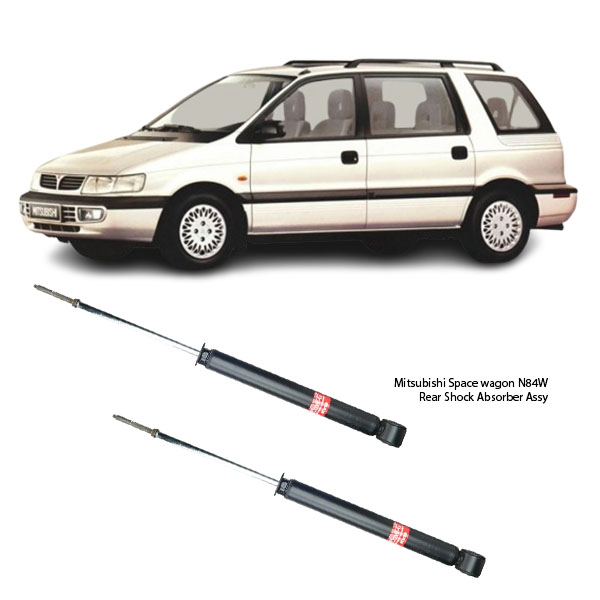Get Mitsubishi Space wagon N84W Rear Shock Absorber Assy 343312 / 343384 in Kenya
Tucked away at the back of your vehicle is one of the most underappreciated components in your suspension system — the Rear Shock Absorber Assembly. While it’s not flashy or loud, it quietly does the heavy lifting of keeping your ride stable, your tires grounded, and your journey smooth. Whether you’re cruising down the highway or maneuvering through bumpy roads, the rear shock absorber plays a crucial role in how safe, comfortable, and responsive your drive feels.
What Is a Rear Shock Absorber Assembly?
The rear shock absorber assembly is a suspension unit designed to manage and dampen the vertical movement of your vehicle’s rear wheels. It works alongside the springs to absorb shocks from bumps, potholes, and uneven terrain — helping keep your tires in consistent contact with the road.
A typical rear assembly includes:
-
Shock absorber (damper) – controls motion using hydraulic or gas pressure
-
Mounting hardware – connects to the frame and rear axle
-
Bushings – insulate vibrations and reduce noise
-
Coil spring (in some designs) – if integrated, it’s referred to as a coilover or strut
These components combine to maintain ride quality, load stability, and rear wheel control, making them a vital part of the driving experience.
How It Works
When the rear wheels encounter a bump or dip, they naturally want to move up and down. The coil spring absorbs the initial shock by compressing, but without a damper, it would continue bouncing. That’s where the shock absorber steps in.
Inside the damper, a piston moves through a fluid-filled chamber. As the suspension compresses and extends, the piston slows down the movement by forcing the fluid through small valves — converting kinetic energy into heat, which dissipates safely.
This process ensures that:
The car doesn’t bounce uncontrollably
The tires maintain steady contact with the ground
Your load stays balanced, especially when carrying cargo or passengers
In essence, the shock absorber turns chaos into control.
Why Rear Shock Absorbers Matter
Although front shocks get more attention, the rear shock absorbers are equally critical. They help ensure:
-
Ride Comfort
Rear shock absorbers absorb road imperfections, keeping the rear of the vehicle from jolting or bouncing. This is especially important when you’re carrying passengers or cargo in the back. -
Stability Under Load
When the rear of the vehicle is loaded, the shock absorbers help maintain height, balance, and control. This prevents sagging or bottoming out during bumps and turns. -
Controlled Braking and Acceleration
Worn rear shocks can cause instability when braking hard or accelerating fast. You might feel the rear sway or lift, reducing grip and safety. -
Improved Traction and Tire Life
Consistent tire contact with the road prevents premature wear and maintains handling quality. Rear shocks help reduce uneven tire wear, especially when the vehicle is loaded.
Signs of a Worn Rear Shock Absorber Assembly
Shock absorbers wear out gradually, often going unnoticed until performance takes a hit. Here’s what to watch out for:
-
Bouncy or unstable ride, especially over bumps
-
Rear-end swaying when turning or changing lanes
-
Clunking noises from the rear on rough roads
-
Oil leaks around the shock body
-
Uneven rear tire wear
-
Longer stopping distances or “nosedive” braking
If your ride feels looser, noisier, or just “off” from the rear — chances are your rear shock absorbers are overdue for inspection or replacement.
What Happens During Replacement?
Replacing rear shocks isn’t just a parts swap. It’s a process of restoring balance and safety. A professional technician will:
-
Lift the vehicle safely and remove the rear wheels
-
Unbolt the old shock assembly from its upper and lower mounts
-
Inspect mounts, bushings, and nearby components for wear
-
Install the new shock absorber assembly
-
Test for stability and handling performance
Depending on the vehicle, some rear shock absorber assemblies also require aligning the suspension for optimal handling.
What Makes a Good Rear Shock Absorber?
Here’s what sets high-quality rear shocks apart:
-
Durability – handles tough terrain and long mileage
-
Consistent damping – balanced ride regardless of load
-
Corrosion resistance – protected from rust and wear
-
Noise reduction – bushings and seals that reduce clunking or rattling
-
Tested performance – built to meet or exceed OEM standards
When properly selected and installed, they should feel invisible — not because they’re unimportant, but because they’re doing their job perfectly.
The Long-Term Benefits
A new set of rear shock absorbers delivers a noticeable difference — not just in comfort but in confidence. You’ll enjoy:
Smoother ride quality
Better road grip and cornering
Safer braking response
Extended tire and suspension life
Reduced wear on other rear-end components
Whether you’re driving daily or carrying heavy loads occasionally, your rear shocks ensure everything rides right.




